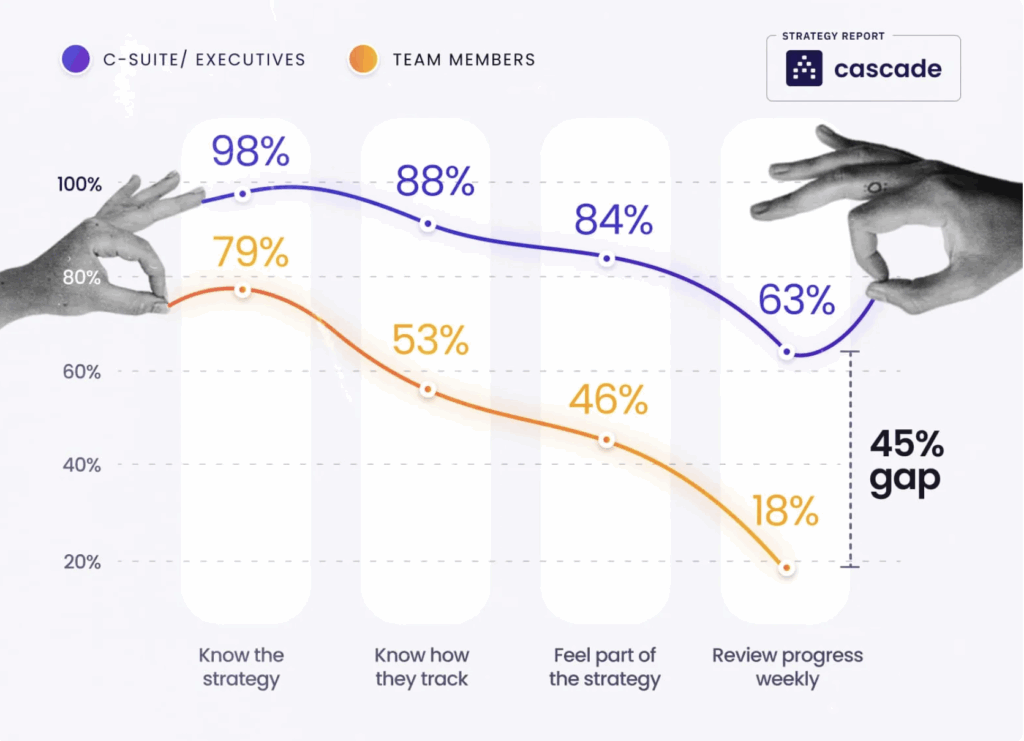As an SME, you may have thought that you don’t need a strategic roadmap, that they are only needed for organisations in the FTSE 100. Or you might not have a strategic plan. A survey by Barclays Bank in 2021 revealed that 47 percent of SMEs have no clear strategy or any kind of strategic planning in place to assist their firm’s growth.
If you are part of the 53% that does have a plan, do you have a strategic roadmap?
Why should a roadmap be important to you?

A strategic roadmap is not a strategic plan. A roadmap is a visualisation of your strategic plan. In summary:
One of the key reasons of why a roadmap is so critical that according strategy company Cascade, Nine out of 10 organisations fail to execute their strategies, often because their plans are too static and remain hidden among leadership, garnering little support from the entire team.
The other fact that makes is so important, is that 53% of team members have no idea whether the company is on track to hit the strategy.

Cascade Strategy Report 2024: You’re Doomed or you Adapt
So, for organisations who think that they do not need a roadmap I ask, can you confidently answer the following questions?
Don’t worry if you answered no to most of these questions, the majority of companies do not have an agile strategic roadmap. Or they work from a whole series of disconnected, task-based project plans that are siloed in nature and don’t make you aware of the bigger picture.
A strategic roadmap will help clarify visions and goals, enhances communication, increases employee engagement and improves decision making.
How well are the company budgets being invested. If your IT Director wants to upgrade your ERP from Version 8.5 to 9 at a cost of £300,000, what benefits will it have for the business as a whole? It might plug a security vulnerability, but what if it just has some shiny new features that are pointless? Should that be on the roadmap, or should that money be invested elsewhere. If you don’t have a clear process for initiative approach you may find that the majority of your company’s budget is invested in areas that are not of strategic importance.
How well have things been thought through, your sales Director wants to increase revenue in Sweden by 35% over the next 12 months. That is great but are you and they are of the work that needs to take place to achieve this. For example you might need.
So, why this might seem like a sales initiative, it will touch on legal, administration, marketing, product and HR. Are they all aware of what will be required of them and when, or is the sales Director dropping things on the laps of people with next to no notice?
A strategic roadmap does not have to be absolute time-boxed like a project roadmap. The timelines can be much more ambiguous, like Now, Next, and Future. In a lot of cases, it should be, as you might need to change direction very quickly as a result of something like a Tariff being placed on imports. But without teams knowing the strategy, what is being thought of, and when, you will always be reactionary.
As a CXO, you will be part of the sign-off for budgetary spending, large and small. Being honest, how many times have you signed something off because it sounded like a good idea without being aware of the complications or even rejected sign off because you were not fully aware of what it meant? How much better would your decision-making be if you forced your direct reports into really thinking about the implications of the decisions they are asking you to make? There is always the issue that you don’t know what you don’t know, but taking the above example, you should know that one decision is going to impact multiple departments.
One of the main issues I have seen from working with organisations over the years is that they have done this thinking, that they are aware of what is happening, but from a roadmap perspective, it is just not very clear. It has either been:
So the question that all business and technology leaders need to ask themselves when it comes to creating a roadmap is, if you and your stakeholders could very quickly:
Would the understanding and consensus of the strategic vision, and therefore by default the strategic plan, be improved and enhanced?
If you do not think so I, I would very much like to know why.
If you do think so, get in touch.
Experience the difference Konexis can make to your strategic communication. Get started and try our roadmap tool for free with a one month trial.
